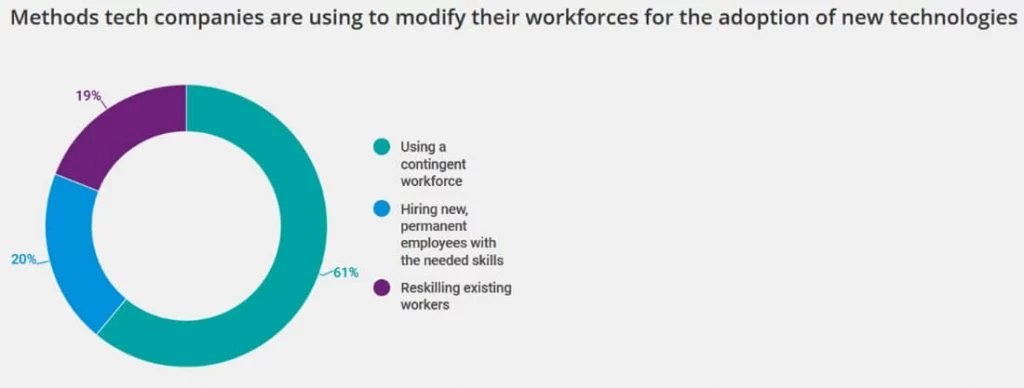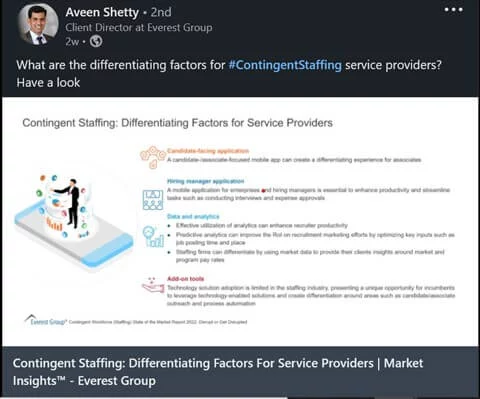The contingency workforce is quickly becoming the largest human capital in the world. Many studies point towards an increasing trend in the freelance economy. By 2050, contingent talent will comprise 50% of the total U.S workforce.
For example, according to Foo See Yang, Country Head at Persolkelly, at least 58% of companies are embracing gig economy in the APAC region to substitute for talent shortages. He also furthers that contingent or flexible staffing is now a C-suite priority and a well-implemented strategy can provide huge benefits in the uncertain post-pandemic world.
Along these lines, Fletcher Wimbush, CPIO at The Hire Talent also opines how contingent employees are great for a limited time or certain activity. His company recently hired a UX/UI designer for a specific new end-to-end hiring project whom he believes has helped complete necessary tasks within the stipulated duration.
Broadly defined, contingent staffing is nothing but ‘hire for talent’. Also called agile talent, many industry experts believe it is the golden ticket to achieving competitive advantage.
Read More: A Beginner’s Guide to Contingent Hiring
An article from No Deviation suggests that companies need to have a contingent workforce strategy to accomplish the intended goals. It should address:
WHY do they need a contingent workforce?
WHAT kind of skills and expertise are needed?
WHERE should they source contingent workers?
HOW can they efficiently manage the contingent workforce?
WHAT is Contingent Hiring?
Amidst many notions, recruitment marketing expert, Shelley Billinghurst believes contingent hiring is similar to contractual hiring. Unlike traditional employment, the workers are hired on an ‘assignment-basis’ only. Therefore, they are not to receive the same salaries and benefits as FTE, but deserve the same support system.
David Bakke, Logistics Expert at National Air Warehouse says that the concept of contingent hiring is all-inclusive. It covers everything from freelancers to temporary workers, interim staff and even a few other types of flexible workforce as well. However, all connotations lead to the fact that they are not actual workers or employees for your company.
WHY should you Hire Contingent Workers?
The post-pandemic world has seen the rise of contingent hiring. Incidentally, contingent talent is leading the agile workforce model across many industries, thanks to its leaner nature and on-demand workforce. In the words of Dan Beck, Co-founder and COO of Utmost, the majority of the global working population will be non-employees within the next two to five years.
According to KPMG, more than 60% of the tech companies look towards contingent workforce for addressing the talent skill gap.

Hiring contingent workers has positive impacts on the business. Among many, it is extremely cost-effective. Since they work on on-demand tenure, their compensation need not include extra benefits.
Also, one can employ or bring them on in an a la carte fashion. Therefore, they can be employed only when the need arises.
However, the team lead at the HVAC-based company cautions about the high-risk disbenefits. For example, contingents come with a high turnover rate. Therefore, it’s always a struggle to find quality talent.
They may lack expertise and you never know what you’re actually getting.
WHERE to Source Contingent Workers
When it comes to hiring contingent workers, the universally accepted best sourcing strategy is ‘Direct Sourcing.’ Traditional sourcing practices for contingent workforce sourcing are very cost intensive and difficult to manage or scale. They also require a lot of time and effort and do not guarantee talent quality, making it difficult to meet talent demands within the allocated time. With quality talent demand increasing rapidly, sourcing candidates has become even more challenging and time consuming.
The only viable solution that enterprises and agencies have discovered to solve their contingent talent sourcing problem is by building an employer brand and network to attract and retain contingent workforce, a method also known as ‘Direct Sourcing.’
Direct sourcing is most effective if you use an external third-party organization such as an MSP (Managed Service Provider) which has the resources, tools, and expertise to attract, evaluate and hire quality contingent talent.
Here are the key benefits of using direct sourcing for building a quality contingent workforce:
- 30-50% lower cost of hiring
- >70% placement rate
- Accelerated time-to-hire
- Enhanced candidate experience
- Boosted talent quality
HOW to Effectively Manage Contingent Hiring Process
- Recruiters must always do detailed homework.
- Stringent background and reference checks come a long way.
- Conduct an in-depth interview process to know what you’re getting.
“Establish a level of trust once you see the contingent worker can competently complete work assignments, but still monitor them from time to time. Take a more active role if you see things running astray.” – David Bakke, National Air Warehouse
Keys to Manage Contingent Workers
Managing contingent workers needs a different approach than full-time employees. From a supervisory standpoint, it is important to
- Have hands-on minus micromanagement.
- Establish a strong rapport to earn trust
- Take a more active role to avoid any repercussions.
On the same lines, Aveen Shetty also highlights how contingent staffing firms can differentiate their services in 4 prominent ways.

Besides, leading studies like Agile Procurement Insights recently reported that more than 55% of the companies believe contingent or external workforce is crucial to conduct business as usual. Helmed as the crux of expertise, contingent workforce management has become a priority across many facets of the recruitment industry today.
There is a plethora of third-party recruitment agencies or freelancing websites to hire contingent workers. Once hired, contingent workers must be managed in the following ways:
- Set clear expectations and goals
- KPIs for work completion
- Schedule recurring meetings
- Get status updates frequently
“Contingent expertise is a great way to fulfill “on-demand” tasks or assignments, even though there isn’t enough consistent work to warrant hiring a full-time employee.” – Fletcher Wimbush, The Hire Talent
The expertise on talent and recruitment further notes that permanent and contingent workers have different value systems. For example, he hints that those contingent workers rarely value workplace loyalty. Therefore, they may not care about the end product like FTE.



